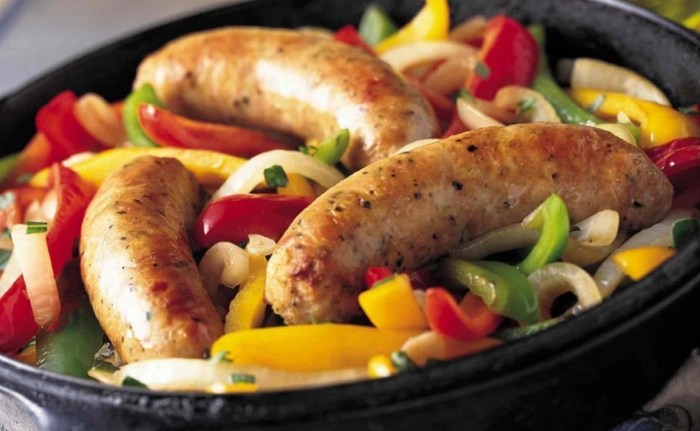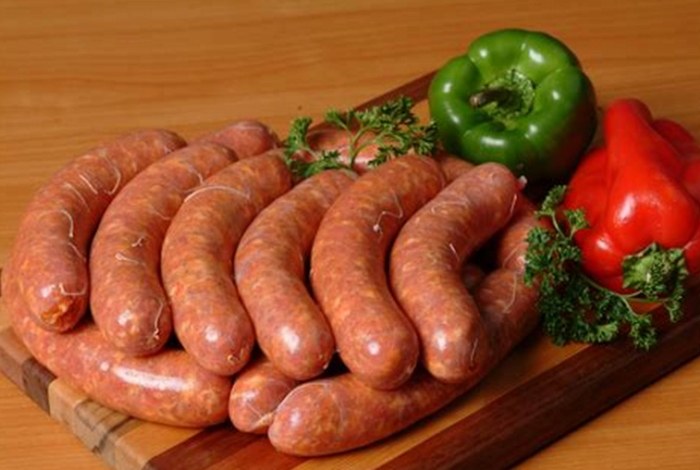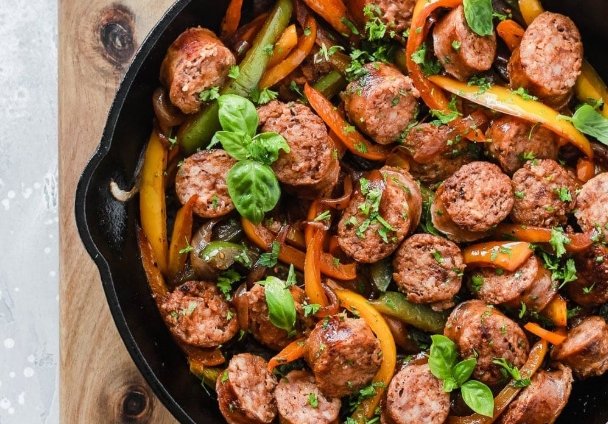Craving Italian sausage? Discover the perfect Italian sausage recipe with pro tips! Learn how to cook Italian sausage perfectly every time, including how long to bake Italian sausage in oven for juicy results. Your ultimate guide to delicious Italian flavors!
Table of Contents
- A Journey Through Time: Tracing the Roots of Italian Sausage
- Crafted with Passion: The Heart of Authentic Italian Sausage
- A Culinary Canvas: Cooking and Savoring Italian Sausage
- A Regional Odyssey: Exploring Italys Sausage Diversity
- Seeking Authenticity: Notable Italian Sausage Destinations
- Q&A: Your Italian Sausage Questions Answered
A Journey Through Time: Tracing the Roots of Italian Sausage

Italian sausage isnt a modern invention; its story is woven tightly with the fabric of Italian history and the fundamental need to preserve precious meat.
Ancient Origins & Practical Necessity
Long before refrigeration, Italians mastered the art of preservation. Salting, curing, and drying meats were essential survival techniques. Evidence suggests sausage-making practices existed in Roman times ("salsus" meaning salted). Farmers and peasants, needing to utilize every part of the pig during the crucial "maialata" (pig slaughter season), developed methods to transform trimmings and lesser cuts flavorful, long-lasting sausages. Early versions were likely coarse, heavily salted, and smoked for extended preservation during harsh winters.
Regional Evolution & Identity
As Italy remained a collection of distinct regions until unification in the 19th century, sausage-making evolved independently. Local climates, available spices (like fennel in the south versus garlic in the north), indigenous pig breeds (Nero Siciliano, Cinta Senese), and cultural preferences led to a dazzling array of styles. Monastic communities also played a role, refining preservation techniques and developing recipes. This regional divergence remains the defining characteristic of authentic Italian sausage today.
The Journey Beyond Italy
Emigration in the late 19th and early 20th centuries carried Italian sausage traditions worldwide, particularly to North America. Immigrants adapted recipes based on available ingredients and local tastes, leading to the sweet and hot varieties now commonly labeled "Italian Sausage" abroad. While delicious, these often differ significantly in spice profile and texture from regional Italian originals.
Crafted with Passion: The Heart of Authentic Italian Sausage

True Italian sausage is more than ground meat in a casing; its an expression of "saper fare" – knowing how to do it right.
The Foundation: Meat ion & Preparation
Traditionally, pork is king. High-quality cuts, predominantly shoulder (coppa/cappello) and belly (pancetta), provide the ideal balance of lean meat and fat – crucial for flavor and juiciness. The meat is meticulously trimmed of sinew and cut chunks suitable for grinding. Respect for the animal means utilizing many parts, contributing to the unique textures found in different regional sausages. The meat must be kept very cold throughout the process to maintain freshness and texture.
Signature Spices & Seasonings
This is where regional identity truly shines. While salt and black pepper are universal, the characteristic flavors emerge from:
- Fennel Seeds: The most iconic spice, especially prominent in Southern Italian sausages (like Luganega from Basilicata/Calabria), providing a sweet, anise-like aroma and crunch.
- Garlic: Ubiquitous, used fresh or dried, adding pungent depth (common in Northern styles like Luganega from Milan).
- Red Pepper Flakes (Peperoncino): Essential for "salsiccia piccante" (hot sausage), adding varying levels of heat depending on the region (Calabria is famous for fiery versions).
- Wine: Sometimes used, particularly red wine in Tuscany ("Salsiccia al Vino Rosso"), adding subtle acidity and complexity.
- Other Regional Touches: Wild fennel pollen (Sicily), orange peel (Sardinia), paprika, coriander, nutmeg, parsley, sometimes cheese (like Pecorino in some Lucanian sausages). The spice blend is meticulously balanced to enhance, not overpower, the pork.
The Encasing Art: Natural Casings
Authenticity demands natural casings, typically made from cleaned hog intestines. These casings are prized for their ability to "snap" when bitten, their permeability allowing smoke and flavors to penetrate during cooking, and the unique texture they impart. The ground, seasoned meat mixture is carefully fed the casings using a sausage stuffer ("insaccatrice"), avoiding air pockets. The sausages are then twisted or tied links of traditional lengths.
Curing & Cooking Traditions
Not all Italian sausage is fresh! Many regions have celebrated cured versions:
- Fresh Sausage (Salsiccia Fresca): Most common, requires thorough cooking. Sold loose or in links.
- Cured Sausage (Salsiccia Stagionata/Salame): Air-dried sausages like the rustic "Salsiccia di Norcia" (Umbria) or finer salamis. These fermented sausages develop complex flavors over weeks or months.
- Smoked Sausage: Found in Alpine regions (e.g., "Luganega Affumicata" in parts of Lombardy/Trentino), cold-smoked for preservation and flavor.
A Culinary Canvas: Cooking and Savoring Italian Sausage

Italian sausages versatility is legendary. It transitions effortlessly from rustic simplicity to elegant complexity.
Essential Cooking Methods
- Grilling (Brace/Griglia): A summer staple. Fresh sausages are grilled over medium charcoal or wood embers until beautifully charred outside and cooked through inside. Cured sausages often accompany antipasti platters. Tip: Prick fresh sausages lightly before grilling to prevent bursting; do NOT prick cured/dried sausages.
- Pan-Frying/Searing (Padella): Perfect for browning sausages before adding to sauces or stews, or cooking them whole. Use moderate heat to render fat slowly and achieve a caramelized crust.
- Roasting/Baking (Forno): Excellent for cooking large batches or sausages with vegetables (peppers, onions, potatoes). Ensures even cooking and allows fat to baste accompanying ingredients.
- Simmering/Braising (Stufato/Brasato): Where sausage truly shines in sauces. Gently simmering sausages in tomato sauce ("Salsicce al Pomodoro"), lentils ("Salsiccia e Lenticchie"), hearty beans ("Fagioli con le Salsicce"), or with cabbage ("Salsiccia e Verza") infuses the dish with deep, savory richness. The sausage fat becomes an integral part of the sauce. Cooking cured sausages (like Cotechino) often involves lengthy simmering.
Iconic Italian Dishes Featuring Sausage
- Pasta Classics: Rigatoni/Rigatoncini con Salsiccia (with tomato sauce), Orecchiette con Cime di Rapa e Salsiccia (orecchiette with broccoli rabe & sausage - Puglia), Lasagna al Ragù di Salsiccia.
- Risotto: Risotto alla Salsiccia e Zafferano (sausage & saffron risotto), Risotto alla Luganega (using the Lombardian sausage).
- Antipasti: Grilled or roasted sausage slices, cured sausage slices, "Spiedini" (skewers).
- Stews & Braises: "Cotechino con Lenticchie" (New Years classic), "Salsiccia e Fagioli allUccelletto" (Tuscan sausage & beans).
- Pizza & Focaccia: "Salsiccia e Friarielli" (Naples - sausage with broccoli rabe), "Salsiccia e Patate".
- Sandwiches/Panini: "Panino con la Salamella" (grilled fresh sausage sandwich - Lombardy), "Rustico Leccese" (Puglian pastry with bechamel, mozzarella, tomato, sausage).
Perfect Pairings: Beyond the Plate
The robust flavors of Italian sausage demand thoughtful companions:
- Wines: High acidity and tannins cut through the fat. Think Chianti Classico, Montepulciano dAbruzzo, Barbera dAlba, Nero dAvola, Lambrusco (with richer preparations), or a crisp Verdicchio with lighter sausage dishes.
- Beers: Malty lagers, amber ales, or hoppy IPAs complement different styles. Italian craft beers like Baladin Isaac or Menabrea Bionda work well.
- Vegetables: Bitter greens (broccoli rabe, chicory), sweet peppers, onions, fennel bulbs, potatoes, lentils, and robust beans (cannellini, borlotti) are classic partners.
- Cheeses: Aged Pecorino Romano, Parmigiano Reggiano, or a creamy Ricotta Salata offer contrasting textures and flavors.
A Regional Odyssey: Exploring Italys Sausage Diversity

To speak of a single "Italian sausage" is a disservice. Each region boasts unique specialties:
Northern Italy: Refinement & Unique Flavors
- Luganega (Lombardy/Veneto/Trentino): The undisputed queen of the North. A long, coiled fresh sausage, often made with finer grind and flavored primarily with garlic, pepper, and sometimes cinnamon or nutmeg. "Luganega alla Griglia" (grilled) is iconic. Smoked versions exist. Often used in risotto.
- Salamella (Lombardy/Piedmont): A shorter, thicker fresh sausage, similar to luganega but coarser, often grilled for panini.
- Cotechino (Emilia-Romagna/Lombardy): A large, cooked, fresh sausage made with pork rind ("cotica"), meat, fat, and spices. Traditionally boiled or simmered slowly and served with lentils on New Years Eve for good luck.
- Zampone (Modena, Emilia-Romagna): Similar to Cotechino, but stuffed a deboned pigs trotter. Boiled and served with lentils.
Central Italy: Hearty & Robust
- Salsiccia di Norcia (Umbria): Famous cured sausage from the Norcia region. Made from prime pork, seasoned with salt, pepper, and sometimes garlic, then air-dried. Celebrated for its intense flavor and firm texture. Often includes chunks of lean meat and fat.
- Salsiccia allUva (Tuscany/Marche): A unique autumn dish where fresh sausages are cooked with grapes (often white Canaiolo), creating a sweet-savory masterpiece.
- Salsiccia di Cinghiale (Tuscany/Umbria): Wild boar sausage, offering a deep, gamey flavor. Can be fresh or cured.
Southern Italy & Islands: Bold Spices & Sunshine
- Luganega/Sasiccia (Basilicata/Calabria/Campania): Often strongly flavored with abundant fennel seeds and peperoncino (hot versions are common). Used in pasta sauces ("Orecchiette con Cime di Rapa"), grilled, or simmered with peppers ("Salsiccia e Peperoni").
- Salsiccia Sarda (Sardinia): Known for its inclusion of myrtle berries ("mirto") or orange peel, offering a distinctive aromatic flavor. Can be fresh or cured ("Salsiccia Secca Sarda").
- Salsiccia alla Brace Siciliana (Sicily): Features prominent fennel seed flavor. Often includes wild fennel pollen. A staple at street food stalls and barbecues. "Salsiccia nel Sardo" involves wrapping sausage in bay leaves before grilling.
- Lucanica (Basilicata): An ancient variety, often coarser, sometimes incorporating Pecorino cheese. Reputed to be an ancestor of the Northern Luganega.
Seeking Authenticity: Notable Italian Sausage Destinations
For the traveling food lover, seeking out authentic sausage experiences is a must. Here are some highlights across Italy and beyond:
Iconic Producers & Shops (Salumifici/Macellerie)
- Antica Salumeria Falcone, Norcia (Umbria): Temple of Norcineria, including exquisite Salsiccia di Norcia.
- Pegaso, SantAngelo in Vado (Marche): Renowned for high-quality cured meats, including unique sausages.
- Salumeria Giusti, Modena (Emilia-Romagna): Historic shop famous for Zampone and Cotechino.
- Macelleria Equina di Angelo Ferri, Castelvetrano (Sicily): Known for authentic Sicilian Salsiccia and other local specialties (including horse meat, a tradition there).
- Local Butcher Shops ("Macelleria") & Markets ("Mercato") everywhere: The best place to find fresh, locally-made salsiccia fresca, often seasoned to the butchers family recipe. Ask for recommendations!
Restaurants Celebrating Sausage
- Trattoria Da Amerigo, Savigno (Emilia-Romagna): Famous for its earthy, traditional dishes, often featuring local cured meats and sausages.
- Antica Trattoria Sacripante, Gragnano (Campania): Near Naples, known for incredible pasta and sausage dishes like "Salsiccia e Friarielli".
- Osteria Le Logge, Siena (Tuscany): Refined Tuscan cuisine where seasonal sausages might feature on the menu.
- Locanda Don Serafino, Ragusa Ibla (Sicily): Elevated Sicilian cuisine showcasing local ingredients, including superb sausages.
- Trattoria Da Enzo al 29, Rome (Lazio): Roman classics done exceptionally well, where "Rigatoni con la Pagliata" (offal sausage) or sausage-based pasta might appear. Always check seasonal menus.
Top Experiences Beyond the Restaurant:
| Experience Type | Location Suggestions | Focus |
|---|---|---|
| Sagra della Salsiccia | Numerous towns across Italy, esp. Jan-Mar | Local sausage festivals - grilled specialties, music |
| Norcia Town | Norcia, Umbria | Heartland of Norcineria (cured meats & sausage) |
| Autumn Truffle Fairs | Alba (Piedmont), Norcia (Umbria), Acqualagna (Marche) | Sausage often paired with fresh truffles |
| Agriturismo Stay | Countryside throughout Italy | Farm stays often produce & serve their own sausage |
| Street Food Stalls | Palermo (Sicily), Naples (Campania), Bologna (Emilia) | Grilled sausage sandwiches (e.g., Salamella, Salsiccia) |
Q&A: Your Italian Sausage Questions Answered
What kind of sausage is Italian sausage?
The term "Italian sausage" can be confusing due to regional differences in Italy versus common usage abroad.
- In Italy: There is no single "Italian sausage." It refers to the vast array of fresh and cured pork sausages made across the country, each with distinct regional names, spice profiles, and preparations (e.g., Luganega, Salsiccia di Norcia, Salamella, Lucanica). Fennel seeds and garlic are common seasonings, but vary hugely.
- Outside Italy (especially North America): "Italian Sausage" usually denotes a specific style of fresh pork sausage link characterized by prominent fennel seed seasoning. It typically comes in two main varieties: Sweet Italian Sausage (mild, seasoned with fennel, garlic, sometimes basil or parsley) and Hot Italian Sausage (similar to sweet, but with significant added red pepper flakes/chili). This style is an adaptation based primarily on Southern Italian influences.
What is in a traditional Italian sausage?
Core ingredients in traditional Italian sausages, particularly fresh varieties ("salsiccia fresca"), include:
- Pork Meat: Primarily shoulder (coppa/cappello) and belly (pancetta), providing lean meat and fat. High-fat content (often 25-30%) is crucial for flavor and moisture.
- Salt: Essential for flavor and preservation.
- Black Pepper: A universal seasoning.
- Signature Spices: This defines the region. Fennel seeds are the most characteristic, especially in the South. Garlic is very common, especially in the North. Red Pepper Flakes (Peperoncino) define hot sausages ("salsiccia piccante").
- Natural Casings: Traditionally made from cleaned hog intestines.
- (Optional/Varies): Wine (sometimes red, sometimes white), other spices (coriander, paprika, nutmeg, cinnamon in the North), herbs (parsley), wild fennel pollen (Sicily), orange peel (Sardinia), cheese (e.g., Pecorino in some Lucanian sausage). Cured sausages involve fermentation and drying.
Is Italian sausage beef or pork?
Authentic Italian sausage, both in Italy and in its traditional forms abroad, is overwhelmingly made from pork. Pork provides the ideal fat content and flavor profile central to Italian sausage recipes. While you might find variations labeled "Italian-style" made with turkey, chicken, or even beef (often for dietary preferences or cost), these are modern adaptations and not representative of the authentic tradition. The unique flavor and texture depend heavily on using pork.
What is Italian sausage on pizza?
When you see "Italian sausage" listed as a pizza topping, especially in pizzerias outside Italy, it almost always refers to crumbled or small pieces of seasoned fresh pork sausage, typically prepared in the "Sweet" or "Hot" style common in North America. This means its seasoned predominantly with fennel seeds and garlic (sweet), plus significant red pepper flakes (hot). On pizza, its usually cooked beforehand (browned and crumbled) or placed raw in small chunks on top to cook in the oven. In Italy, pizza toppings vary regionally, but sausage ("salsiccia") on pizza (like the famous "Salsiccia e Friarielli" in Naples) uses locally made fresh pork sausage, seasoned according to that specific areas tradition – often featuring fennel prominently.
About the author:I’m Frank, the traveler and foodie behind Italy Travel Guide. For over a decade, I’ve been exploring every corner of Italy—from the canals of Venice to the lemon groves of the Amalfi Coast—sharing the best hidden gems, authentic trattorias, and charming boutique hotels along the way. My passion? Helping you experience Italy like a local, whether that means finding the perfect tiramisu in Florence, navigating Italy’s train system like a pro, or uncovering that tiny family-run vineyard in Tuscany. Join me as we dive la dolce vita, one unforgettable adventure at a time!
